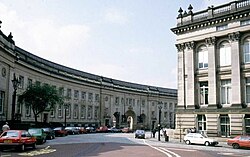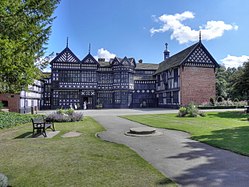This article needs additional citations for verification .(February 2016) |
This is a list of places of interest in the British county of Greater Manchester. See List of places in Greater Manchester for a list of settlements in Greater Manchester.
This article needs additional citations for verification .(February 2016) |
This is a list of places of interest in the British county of Greater Manchester. See List of places in Greater Manchester for a list of settlements in Greater Manchester.
| Name | Image | Location | Description |
|---|---|---|---|
| Bolton Museum |  | Bolton | Museum and art gallery including collections of natural history, archaeology, art and local history, as well as one of Britain's oldest public aquariums. |
| Bolton Steam Museum |  | Bolton | Museum housing a variety of preserved steam engines. |
| Hall i' th' Wood |  | Bolton | 16th century manor house that was the home of Samuel Crompton and was where he designed and built the first spinning mule. Grade I listed building. |
| Name | Image | Location | Description |
|---|---|---|---|
| Bury Art Museum |  | Bury | Museum and art gallery that is home to the Wrigley Collection, an assemblage of over two hundred oil paintings, watercolours, prints and ceramics accumulated by the Victorian paper manufacturer Thomas Wrigley. |
| Fusilier Museum |  | Bury | Museum housing the collection of the Lancashire Regiment, commemorating over three hundred years of the regiment's history. |
| Radcliffe Tower |  | Radcliffe | Remains of a fortified manor house built in 1403 by James de Radcliffe. Grade I listed building. |
| Name | Image | Location | Description |
|---|---|---|---|
| Gallery Oldham |  | Oldham | Art gallery and natural history museum. |
| Name | Image | Location | Description |
|---|---|---|---|
| Ellenroad Mill |  | Newhey | Former cotton spinning mill, part of which now forms the Ellenroad Ring Mill Engine, a preserved stationary steam engine. |
| Name | Image | Location | Description |
|---|---|---|---|
| The Lowry |  | Salford Quays | |
| Name | Image | Location | Description |
|---|---|---|---|
| Bramall Hall |  | Bramhall | 14th century Tudor manor house that is the ancestral home of the Davenport family. Grade I listed building. |
| Hat Works |  | Stockport | Museum located in Wellington Mill, an early fireproof cotton spinning mill. Grade II listed building. |
| Name | Image | Location | Description |
|---|---|---|---|
| Buckton Castle |  | Stalybridge | Medieval ringwork remains of a castle with a curtain wall built by William de Neville in the late 12th century. |
| Name | Image | Location | Description |
|---|---|---|---|
| Dunham Massey Hall |  | Dunham Massey | Moated hall built in 1616 by Sir George Booth.[ citation needed ] Grade I listed building. [1] |
| Imperial War Museum North |  | Trafford Park | |
| Name | Image | Location | Description |
|---|---|---|---|
| Astley Green Colliery Museum |  | Astley | Former working colliery that produced coal from 1912 to 1970. It is now a museum and has the only surviving pit headgear and engine house on the Lancashire Coalfield. Grade II listed building. |
| Haigh Hall |  | Haigh | Country house built in 1827-40 by James Lindsay, 24th Earl of Crawford, it remaining the seat of the Lindsay family until 1947. Grade II* listed building. |
| Haigh Windmill |  | Haigh | Tower mill built in 1845. It is the only remaining windmill in Greater Manchester. |